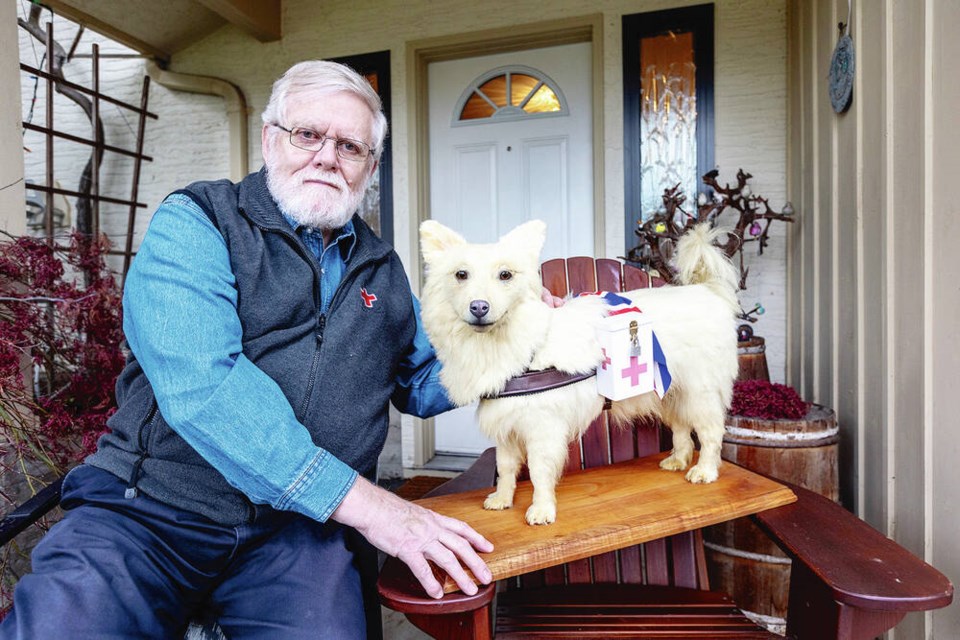He was a very good boy — and for a time, he was one of Victoria’s best charity fundraisers until he died of pneumonia at the age of seven.
Muggins the fundraising dog wandered downtown streets during the First World War, wearing two donation boxes tied to his back to collect funds for the Red Cross and other charities. When the donation boxes grew heavy, he would return to his owner, Beatrice Woodward, on Fort Street.
The fluffy white purebred Spitz collected more than $21,000 (about $330,000 by current standards) for charity and was a downtown fixture during his short lifetime.
He was so well known that a fight nearly broke out when Muggins was picked up by animal control near the Empress Hotel. The mayor was called and a police officer suggested the poundkeeper “use a little sense” and return the famous Red Cross collector dog, according to a 1919 story in the Daily Colonist.
Despite being preserved by a taxidermist to continue his fundraising career, Muggins eventually disappeared in the 1940s or ‘50s.
Paul Jenkins, co-ordinator of the B.C./Yukon history project at the Red Cross, kept Muggins’s story alive with blog posts chronicling the little dog’s extraordinary life, but he figured he was gone for good.
Until he received a call from a View Royal woman who believed Muggins was in her shed.
“I was over there in a flash,” Jenkins said. “I knew it was him right away.”
Jo-Ann Gallagher had seen Jenkins and photos of Muggins in a news story about a 2021 biography of the dog by local writer Grant Hayter-Menzies.
“That looks like the dog you have,” Jo-Ann Gallagher remembers telling her husband, Phil Sommerard.
She contacted Jenkins to let him know she thought she might have the missing dog.
“He was over the moon,” Sommerard said.
Muggins had made his way to their house from a friend’s attic. Dave Citra found the dog in his family home in Colwood when he was cleaning out the house for sale.
Citra remembers meeting the stuffed Muggins as a young child when the taxidermy version was still fundraising. He would put a donation in the metal boxes and pet the dog.
He doesn’t know how Muggins came to the home, but he remembers him on display in the living room for a few years from about 1955, before being moved to the attic. He was pretty much forgotten for the next 60 years, until Citra was emptying the attic.
He didn’t want to get rid of the dog, but he didn’t know what to do with it, either.
“I remembered there was quite a bit of story around it,” he said.
Sommerard volunteered to take him. After putting Muggins in various places that kept scaring his tenant’s partner, who was terrified of dogs, Sommerard relegated Muggins to the shed, where he would stay dry.
Muggins is now at home with Jenkins, while a plexiglass case is made for him so that he can be put on display at the Costume Museum at Government House. An unveiling is planned for the spring, he said.
“When I’m in my workshop, I can’t help talking to him, because he really is a presence,” Jenkins said.
He was in surprisingly good shape after sitting in an attic for 60 years, Jenkins said, but he needed a little love. He was restored to his former glory by a taxidermist in Mission.
Hayter-Menzies, who wrote the biography, Muggins: The Life and Afterlife of a Canadian Canine War Hero, covered the cost of restoration and took Muggins to the mainland to be restored.
“Everybody in Victoria loved this little dog, so when he died, it was like a local, beloved celebrity had died. People wrote poems in his memory. People donated money,” Hayter-Menzies said. He was known in the U.S., where he had been given an officer’s rank by the U.S. Navy, and in England, he said. The medals he received from the American and French Red Cross for his war efforts are now at the Saanich archives.
Hayter-Menzies is glad to hear Muggins will have a new home at Government House.
“Hopefully he won’t end up in an attic again,” he said.



